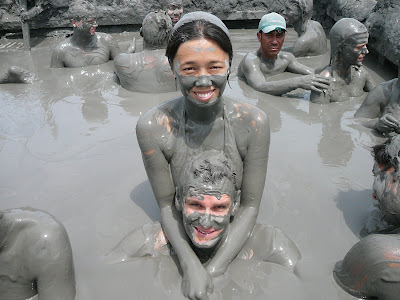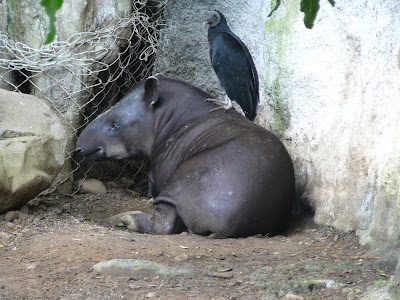From Panama there is no good way to get to South America by road. The Darien Gap is passable on a motorbike in the dry season if you manage to avoid the guerrillas in the area. Many sailboats take tourists back and forth between Panama and Cartagena, Colombia, taking five days and apparently being quite a good trip. But we chose to fly. This was a reasonable option but we had some problems: Firstly we were required to have tickets out of the country which we didn't plan on buying, and secondly, a lady at the airport wanted us to carry on her unaccompanied baggage. We were coerced into buying return tickets that, after much time and negotiation, were refunded in Colombia. As for the mystery bag, she convinced another stranger to carry it.
 Coffee
CoffeeIt was worth it though, beacause we ended up here in Cartagena, a beautiful colonial city on Colombia's Caribbean coast. The architecture is European and the atmosphere tropical and colourful.
We took a day trip to a 15 metre high volcano that is slowly spewing mud. The mud is really dense and you float on top. You can also push people around and they slide across the top of it. Lots of fun!
 A mud bath
A mud bathFrom Cartagena we flew to Medellin, where Luisa's friends Alejandro and Magdalena are from. Medellin used to be the drug capital of the world and a dangerous place with "a lot of death" as the locals say. It was famous for the Medellin Cartel until its leader Pablo Escobar was hunted down and executed. However, significant changes and a new Colombian president mean it is now one of the safest cities in Latin America. The residents are positive about the future of their city and very welcoming - in this way it felt a bit like Croatia. It is high on our list of favourite places so far. That could be because we splurged on a grand old five star hotel with a pool, gym, sauna and buffet breakfast for about the same price as a dorm in Europe! Medellin is also proud of its beautiful, very large-busted women, helped by the presumably thriving cosmetic surgery industry.
In Colombia, drinking in public is accepted and common. Rather than trying to curb it, police just make sure that they are well represented and the public parks and squares have good atmospheres at night. So one night we just sat in a park drinking aguardiente (like Sambuca) watching the locals, who were all dressed in costumes, go about partying. It was never clear what the celebration was for, but that wasn't the point.
A highlight of Medellin was visiting the art gallery and seeing many works of art interpreting the time of violence. On another theme, Colombia's famous artist Fernando Botero, famous for his distinctive "gordos" (fat people), has work displayed all over the city in statues and paintings.
 Clown entertaining traffic for tips
Clown entertaining traffic for tipsA fun feature of Medellin is that its metro system includes a cable car ride up a hill over the outlying suburbs, for no extra charge!
The Colombian president, Alvaro Uribe is strongly committed to combating guerrilla groups, mainly because his father was tortured and killed by one in the 1980s. Violent crime was halved during his first two years of office and the military presence is now strongly felt. During most journeys in Colombia, the bus would stop at military checkpoints where Roger and the rest of the men would be lined up and patted down by police. Meanwhile, the women would watch the proceedings from the comfort of their seats.
 Parque Las Nevadas
Parque Las NevadasManizales is a town situated near the Colombian Andes where snow falls a few degrees north of the equator. We took a tour with a few jovial Colombians (as they all are) to a national park, El Parque Las Nevadas, to see snow at 4800 metres. We then walked to 5100 metres, which is not the top of the volcano, but it was enough given that we weren't acclimatised.
Solento is a sleepy country town in the highlands further south on the road from Medellin. It is popular with locals for a famous valley of wax palms nearby. It was here we were able to hire horses for the day and ride around without a guide - at last!
We walked to the top of a hill where an old man was waiting and pointed out the cemetery: "It's only a small one... not many people die here".
Next we went to Cali where apparently the beauties (natural and enhanced) rival those from Medellin. There is also a good zoo that breeds, rehabilitates and releases animals like condors into the wild. The animals seemed well cared for and it was a pleasant change from all the starving street dogs in central america.
Colombians like their music and they like to party. Even supermarkets play salsa instead of elevator music. Old painted "chivas" (buses) regularly take partygoers on a ride around town with live music and aguardiente on board.
However, we chose to attend a free classical music concert instead and hear an impressive rendition of Beethoven's "Pathetique", on a Steinway no less.
While flicking channels on cable TV we came across Las Aventuras de Bindi. The whole Irwin family was dubbed into Spanish. "Crikey!" doesn't quite have the same effect with a heavy Spanish accent.
Las Lajas, near the Ecuadorian border, is where a stunning church was built spanning a gorge because someone once saw a vision of the Virgin Mary there. It is a popular prilgramige site for locals and you can also sit on a llama and have your photo taken in the carpark for 50 cents - cool, no?
 Luisa and short llama
Luisa and short llamaWe enjoyed Colombia mainly because of the Colombians who are a charmingly polite and gracious breed. We were often approached just because people were interested in talking to us. This is most likely the result of the small number of travellers who come here and the ones who do are largely English and European compared to the large number of Americans from the US in Central America. Outside of Cartagena we only met two other foreigners in total and they were bicycle tourists.
















No comments:
Post a Comment